
Absalon was a Danish statesman and prelate of the Catholic Church who served as the bishop of Roskilde from 1158 to 1192 and archbishop of Lund from 1178 until his death. He was the foremost politician and church father of Denmark in the second half of the 12th century, and was the closest advisor of King Valdemar I of Denmark. He was a key figure in the Danish policies of territorial expansion in the Baltic Sea, Europeanization in close relationship with the Holy See, and reform in the relation between the Church and the public. He combined the ideals of Gregorian Reform with loyal support of a strong monarchical power.
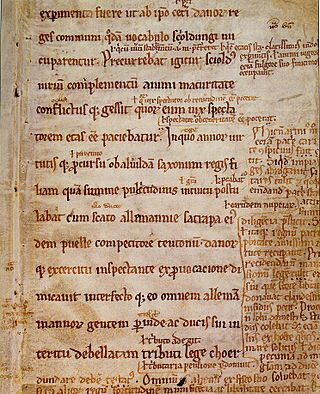
Gesta Danorum is a patriotic work of Danish history, by the 12th-century author Saxo Grammaticus. It is the most ambitious literary undertaking of medieval Denmark and is an essential source for the nation's early history. It is also one of the oldest known written documents about the history of Estonia and Latvia.
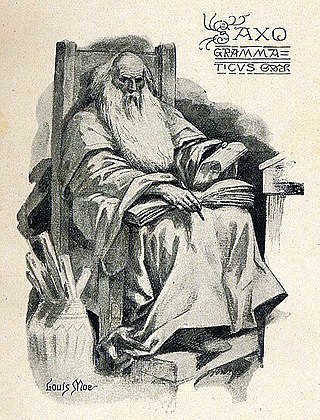
Saxo Grammaticus, also known as Saxo cognomine Longus, was a Danish historian, theologian and author. He is thought to have been a clerk or secretary to Absalon, Archbishop of Lund, the main advisor to Valdemar I of Denmark. He is the author of the Gesta Danorum, the first full history of Denmark, from which the legend of Amleth would come to inspire the story of Hamlet by Shakespeare.

Olaf I, nicknamed Olaf Hunger, was king of Denmark from 1086 to 1095, following the death of his brother Canute IV the Holy. He was a son of king Sweyn II Estridsson, and the third of Sweyn's sons to rule. He married Ingegard, the daughter of Harald Hardråde, but did not have any sons. He was succeeded by his brother Eric the Good.
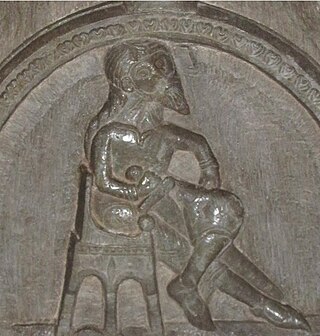
Sverker the Elder, also known as Sverker I, was King of Sweden from about 1132 until his murder. Of non-royal descent, he founded the House of Sverker, the rulers of which alternated with the rival House of Erik over the next century.
Magnus the Strong, also known as Magnus Nilsson, was a Danish duke who ruled Götaland in southern Sweden from the 1120s to c. 1132. It is disputed whether he was elected king by the Swedes, but he is nevertheless sometimes found in the modern list of Swedish monarchs as Magnus I. Snorri Sturlason gives him the epithet "Strong".

Thyra was the wife of King Gorm the Old of Denmark, and one of the first queens of Denmark widely believed by scholars to be historical rather than legendary. She is presented in medieval sources as a wise and powerful woman who ordered the building or fortification of the Danevirke, consistent with her commemoration on multiple Viking Age runestones. These include those at Jelling which was the seat of power for her dynasty.
Eskil was a 12th-century Archbishop of Lund, in Skåne, Denmark.

Runamo is a cracked dolerite dike in Sweden that was for centuries held to be a runic inscription and gave rise to a famous scholarly controversy in the 19th century. It is located 2.7 km from the church of Bräkne-Hoby in Blekinge, in South-Sweden. For hundreds of years people said it was possible to read an inscription, and learned men referred to it.
Webiorg, Wigbiorg or Veborg, was a legendary Scandinavian shieldmaiden who, according to the sagas, participated in the Battle of Bråvalla, which occurred in Sweden in approximately 750. She was of Swedish or Danish origin.
Henry was an Obotrite prince or king (1093–1127) from the Nakonid dynasty; he was regarded by contemporaries as "King of the Slavs". The Obotrite realm reached its greatest area during Henry's rule, extending from the Elbe to the Oder and from the Havelland to the Baltic Sea.
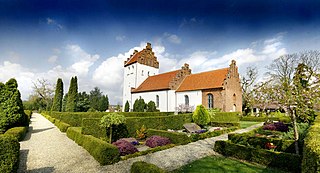
Skjalm Hvide, was the Earl of Zealand in Denmark in the end of the Viking Age (793–1066) and up to his death. Skjalm's father was Toke Trylle, whose father was Slag, based on Absalon, a medieval account scanned, translated and published by Google.

Absalon's Castle, was a fortification on the island of Slotsholmen in Copenhagen, located at the site of the later Copenhagen Castle and Christiansborg Palace. According to the chronicler Saxo Grammaticus, the castle was founded by Bishop Absalon in 1167 to protect the emerging city of Copenhagen. The castle survived for 200 years before it was destroyed in 1369 by the Hanseatic League, who first occupied and plundered it, and then demolished it completely.

The Confraternity of Belchite was an "experimental" community of knights founded in 1122 by Alfonso the Battler, king of Aragon and Navarre, and lasting until shortly after 1136. Members could enlist permanently or for a set time, vowing "never to live at peace with the pagans but to devote all their days to molesting and fighting them". When the Emperor Alfonso VII confirmed the charter of the confraternity, he specified that it existed "for the defence of Christians and the oppression of Saracens". A Christian organisation dedicated to a holy war against Muslims (reconquista), its impetus and development coincide with that of the international military orders and it introduced the concept of an indulgence proportional to length of service.
Henrik Svendsen, better known as Henrik Skadelår or Henrik the Lame, was a Danish prince and pretender through his father, Svend Tronkræver, an illegitimate son of King Sweyn II. He died in the Battle of Fotevik before he could press his claim.
Tetzlav, also known as Tezlaw, Tetzlaw and Tetislaw was a Prince of Rügen.
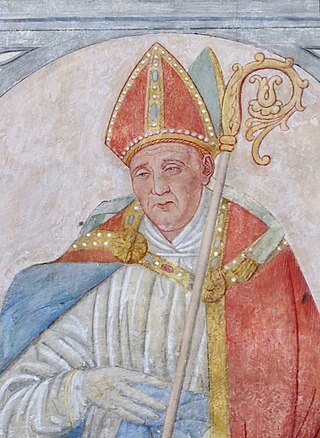
William of Roskilde was a Danish prelate of the Roman Catholic Church who served as the Bishop of Roskilde in Denmark from about 1060.

Esbern Snare, also known as Esbern the Resolute, (1127–1204) was a høvding, or chieftain, royal chancellor and crusader. His family were members of the powerful Hvide clan. In 1192, during the Crusades and after the fall of Jerusalem, he led a small group of Danish soldiers to the Holy Land. Upon his return, he had the Church of Our Lady, Kalundborg built.

The Danish Civil Wars were a series of civil wars fought in the Kingdom of Denmark, first from 1131 to 1134 over the murder of Canute Lavard, then from 1139 to 1143, and finally a war of succession fought from 1146 to 1157, after the abdication of Eric III of Denmark, the first monarch in Danish history to have abdicated. The first phase of the war was fought between King Eric II of Denmark and King Niels joined by Magnus the Strong. The second phase of the war was fought between the son of Magnus the Strong, Canute V of Denmark, the son of Eric II of Denmark, Sweyn III of Denmark, and his cousin Valdemar I of Denmark, son of Canute Lavard. The civil wars marked an increase in the influence of the Holy Roman Empire in Denmark, and for a time after, Denmark was a vassal state of Emperor Frederick I. The war ended with the deaths of seven kings. Two of the kings, Olaf Haraldsen and Magnus the Strong, are not amongst the official Danish line of kings. The other kings are Niels I, Eric II, Eric III, Canute V and Sweyn III.

The Valdemarian Age commonly also referred to as the Valdemars refers to an 84-year long period in Danish history between 1157 and 1241, beginning with the reign of Valdemar I, and ending with the death of Valdemar II. The period is heavily centered around the Danish Crusades in the Baltic Sea.